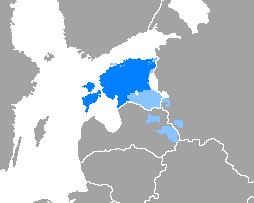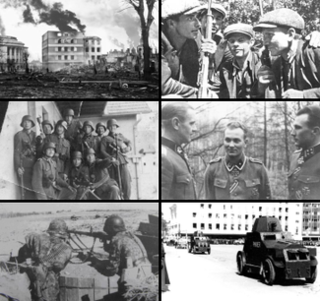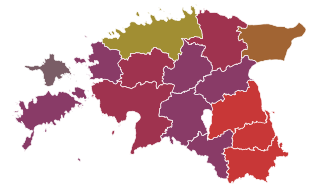
Estonian is a Uralic language of the Finnic branch spoken in Estonia. It is the official language of Estonia, spoken natively by about 1.1 million people; 922,000 people in Estonia and 160,000 outside Estonia. It is a Southern Finnic language and is the second-most-spoken language among all the Finnic languages.

Tallinn is the capital, the most populous and the primate city of Estonia. Located in the northern part of the country, on the shore of the Gulf of Finland of the Baltic Sea, it has a population of 437,619 in 2020. Administratively a part of Harju County, Tallinn is the main financial, industrial and cultural centre of Estonia; the second largest city, Tartu, is located in the southern part of Estonia, 187 kilometres (116 mi) southeast of Tallinn. Tallinn is located 80 kilometres (50 mi) south of Helsinki, Finland, 320 kilometres (200 mi) west of Saint Petersburg, Russia, 300 kilometres (190 mi) north of Riga, Latvia, and 380 kilometres (240 mi) east of Stockholm, Sweden. From the 13th century until the first half of the 20th century Tallinn was known in most of the world by its historical German name Reval.

Tartu is the second largest city of Estonia, after Estonia's political and financial capital Tallinn. It is situated 186 kilometres southeast of Tallinn and 245 kilometres northeast of Riga, the capital of Latvia. The distance to Estonia's summer holiday capital Pärnu in the west is 176 kilometres and the fastest route there by car is through Viljandi and Kilingi-Nõmme. Tartu lies on the Emajõgi, which connects the two largest lakes of Estonia, Lake Võrtsjärv and Lake Peipus. The city is served by Tartu Airport.

The Baltic Germans are ethnic German inhabitants of the eastern shores of the Baltic Sea, in what today are Estonia and Latvia. Since their resettlement in 1939, Baltic Germans have markedly declined as a geographically determined ethnic group. It is estimated that several thousand still reside in Latvia and Estonia.

The Baltic states, also known as the Baltic countries, Baltic republics, or simply the Baltics, is a geopolitical term, typically used to group the three sovereign states on the eastern coast of the Baltic Sea: Estonia, Latvia, and Lithuania. The term is not used in the context of cultural areas, national identity, or language, because while the majority of people in Latvia and Lithuania are Baltic people, the majority in Estonia are Finnic. All three states are part of the European Union. The three governments engage in intergovernmental and parliamentary cooperation. There is frequent cooperation in foreign and security policy, defence, energy, and transportation.

Pärnu is the fourth largest city in Estonia. Tallinn, the capital city of Estonia, is 128 kilometres (80 mi) north of Pärnu, and Tartu, Estonia's second largest city, is 176 kilometres (109 mi) east of Pärnu. Located in southwestern Estonia on the coast of Pärnu Bay, an inlet of the Gulf of Riga in the Baltic Sea. It is a popular summer holiday resort with many hotels, restaurants, and large beaches. The Pärnu River flows through the city and drains into the Gulf of Riga. The city was served by Pärnu Airport.

Counties are the first-level administrative subdivisions of Estonia. Estonian territory is composed of 15 counties, including 13 on the mainland and 2 on islands. The government of each county is led by a maavanem (governor) who represents the national government at the regional level. Governors are appointed by the national government for a term of five years.

Estonians are a Finnic ethnic group native to Estonia who speak the Estonian language and share a common culture and history.

MS Estonia was a cruiseferry built in 1980 at the German shipyard Meyer Werft in Papenburg. In 1993, she was sold to Nordström & Thulin for use on Estline's Tallinn–Stockholm route. The ship's sinking on 28 September 1994, in the Baltic Sea between Sweden, Åland, Finland and Estonia, was one of the worst maritime disasters of the 20th century.

The Estonian War of Independence, also known as the Estonian Liberation War, was a defensive campaign of the Estonian Army and its allies, most notably the White Russian Northwestern Army, Latvia, and the United Kingdom, against the Soviet Western Front offensive and the aggression of the Baltische Landeswehr. It was fought in connection with the Russian Civil War during 1918–1920. The campaign was the struggle of Estonia for its sovereignty in the aftermath of World War I. It resulted in a victory for the newly established state and was concluded in the Treaty of Tartu.

The Riigikogu is the unicameral parliament of Estonia. All important state-related questions pass through the Riigikogu. In addition to approving legislation, the Riigikogu appoints high officials, including the Prime Minister and Chief Justice of the Supreme Court, and elects the President. The Riigikogu also ratifies significant foreign treaties that impose military and proprietary obligations, bring about changes in the law, etc.; approves the budget presented by the government as law and monitors the executive power.

FC Flora, commonly known as Flora Tallinn, or simply as Flora, is a professional football club based in Tallinn, Estonia, that competes in the Meistriliiga, the top flight of Estonian football. The club's home ground is A. Le Coq Arena.

The Estonia national football team represents Estonia in international football matches and is controlled by the Estonian Football Association, the governing body for football in Estonia. Estonia's home ground is A. Le Coq Arena in Tallinn.

The Estonian Football Association is the governing body of football, beach soccer and futsal in Estonia, established on 14 December 1921. It organizes the football league, including the championship which is called Meistriliiga, Estonian Cup and the Estonian national football team. It is based in Tallinn. EJL became a member of FIFA in 1923, but following Estonia's annexation by the Soviet Union it was disbanded. It became a member again in 1992 after Estonia reinstated its independence.

Populated places in Estonia, are cities or settlement units of rural municipalities, but only cities have administrative functions. Settlement units are divided into settlements and urban regions.

Before the outbreak of the Second World War, Germany and the Soviet Union signed the German-Soviet Nonaggression Pact, concerning the partition and disposition of sovereign states, including Estonia, and in particular its Secret Additional Protocol of August 1939.

The Estonian Soviet Socialist Republic was a republic of the Soviet Union. The ESSR was initially established on the territory of the Republic of Estonia on 21 July 1940, following the occupation of Soviet troops on 17 June 1940 and the installation of a communist government backed by the Soviet Union, which declared Estonia a Soviet constituency. Estonia was subsequently incorporated into the Soviet Union as a Soviet Republic on 6 August 1940. The territory was occupied by Nazi Germany in 1941 and administered as a part of Reichskommissariat Ostland until it was reconquered by the Soviet Union in 1944 during World War II.

Estonia, officially the Republic of Estonia, is a country in Northern Europe. It is bordered to the north by the Gulf of Finland across from Finland, to the west by the Baltic Sea across from Sweden, to the south by Latvia, and to the east by Lake Peipus and Russia. The territory of Estonia consists of the mainland and of 2,222 islands on the eastern coast of the Baltic Sea, covering a total area of 45,227 km2 (17,462 sq mi), and is influenced by a humid continental climate. Tallinn, the capital of Estonia, and Tartu are the largest cities and urban areas in the country. Other notable cities include Narva, Pärnu, Kohtla-Järve and Viljandi. The official language of the country, Estonian, is the second-most-spoken Finnic language.

The COVID-19 pandemic in Estonia is part of the ongoing worldwide pandemic of coronavirus disease 2019 caused by severe acute respiratory syndrome coronavirus 2. The virus was confirmed to have spread to Estonia when the first case was confirmed in Tallinn on 27 February 2020. By 11 March, 15 people in Estonia had been diagnosed with the virus. All of them had been infected outside the country, mostly in Northern Italy. On 12 March, the first cases of locally transmitted infections emerged, and on 13 March, the Estonian government declared a state of emergency until 1 May 2020. As a result, all schools and universities were closed, and all public gatherings banned, including sports and cultural events. Later the state of emergency was extended until 17 May.
A list of films produced in Estonia ordered by year of release. For an alphabetical list of Estonian films, see Category:Estonian films


















